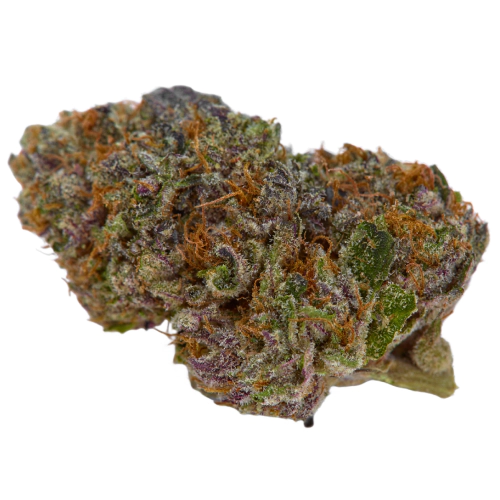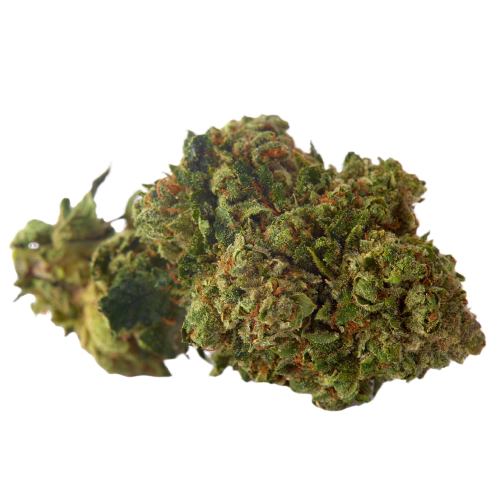THC 17.5 - 23%
CBD 0.05 - 1.13%
Effect Energetic
Flavor Mango
22 - 26%
0.11 - 0.26%
0.07 - 0.1%
Sweet, Tobacco
Sleepy
White Guava, sometimes called White Hot Guava, is a pure Indica strain created by the San Jose Patients Company. However, its parent strains remain unknown. But from them, White Guava inherited the ability to provide the most potent high. Its primary cannabinoids are THC and CBD. THC levels range from a high 22 to 26%, which will surprise even experienced smokers. But beginners should not begin their acquaintance with the world of marijuana through this cannabis strain. The CBD amount is low, 0.11 - 0.26%. White Guava strain taste and aroma are recognizable thanks to:
White Guava weed strain has cone-shaped bright green buds, densely covered with light amber hairs and a small web of white trichomes.
Carene, along with humulene, forms a strong aroma that resembles tobacco with a sage undertone. On the contrary, the taste is quite sweet thanks to myrcene. Linalool leaves a citrus aftertaste.
Stoners claim that high does not come immediately, but it does not leave smokers for another hour and a half to two hours after several puffs. The effects begin with a feeling of heaviness in the body, provoking couch-lock. The White Guava experience is excellent for an evening because it makes users feel relaxed and sleepy at the end of the high.
White Guava is a beneficial cannabis strain for combating:
This kush can cause some side effects, for example:
Dispensaries rarely offer White Guava strain seeds, so finding them is difficult. It is a photoperiod plant that averages 30-60 inches. Despite its small growth, it gives a lot of yields. Thus, a plant cultivated outdoors yields approximately 400 g / m², while an outdoor yield is 400 g / plant.
If you are interested in growing this weed strain, you will be delighted with its flowering period. It ranges from 53 to 61 days, but you can start harvesting as early as day 58.
| THC | Tetrahydrocannabinol, or THC, is a major cannabis chemical compound. It is a psychoactive element that stimulates dopamine release and induces euphoria or happiness. THC-rich strains may be helpful with such conditions as lack of appetite, chronic pains , etc. It is considered to be the primary active marijuana component. | 22 - 26% |
| CBD | Cannabidiol, or CBD, is a major compound in cannabis, which is non-psychoactive. It is also proved to counteract the side effects of the second major component THC. CBD is widely used for medicinal purposes in rubs, oils and so on. It is helpful in muscle pain cases, may treat arthritis and migraines. Even Greeks used it against pain, while Queen Victoria applied it to get rid of menstrual cramps. | 0.11 - 0.26% |
| CBC | Cannabichromene, or CBC, is a minor cannabinoid, meaning that its quantity in cannabis is quite little. Though it has the same origin as CBD and THC, it is different in functions. Without any psychoactive effects, it is an efficient cannabis compound in combating acne and depression. CBC produces analgesic, antibacterial and anti-inflammatory effects. | 0.29 - 0.4% |
| CBG | Cannabigerol, or CBG, is one of the minor cannabis compounds in adult plants. On the other hand, young ones contain a lot of this antibacterial and anti-inflammatory component. During the growth, CBG is converted into different cannabinoids, mostly THC and CBD. The compound itself increases appetite and decreases eye pressure. | 0.07 - 0.1% |
| CBN | Cannabinol, or CBN, is a trace element in cannabis that is considered to be mildly psychoactive. It appears from oxidation THC, exposed to light and heat. CBN is mostly contained in old cannabis and in traditional hashish. It is effective against insomnia, bacterial infections and appetite loss. | 0.1 - 0.19% |
| THCV | Tetrahydrocannabivarin, or THC-V, is a compound contained in cannabis in trace amounts. Even though it is close to THC molecularly, it is different in effects. This compound may be psychoactive only in large amounts. THC-V reduces blood sugar, controls appetite, stimulates bone growth, etc. African Sativa strains are the richest in THC-V. | 0.49 - 0.68% |
| Carene | Carene (also known as Delta-3 carene) is a terpene found in rosemary, lemons, pines, and cedars, offering citrusy and cypress aroma. Studies on mice showed that carene provides anti-inflammatory effects, as well as promotes bone health and chronic pain relief. | 0.12% |
| Pinene | Pinene is one of the most widespread terpenes in nature, found in pine trees, basil, nutmeg, parsley, and rosemary. Cannabis containing terpene (alpha-pinene or α-pinene) boasts a strong pine scent. Pinene is responsible for anti-inflammatory, pain-relieving, and anti-anxiety effects. | 0.11% |
| Myrcene | Myrcene (also known as β-myrcene) is one of the most common terpenes found in cannabis, representing more than 20% of the modern marijuana terpene profile. Myrcene has a distinct earthy, musky flavor, resembling cloves. It is responsible for calming and soothing effects of weed. Myrcene is also found in hops, thyme, mango, lemongrass, guava melon. | 0.28% |
| Humulene | Humulene (also known as α-humulene) is one of the major terpenes found in cannabis, contributing to woody, earthy, spicy, herbaceous, and, mainly, floral aromas of cannabis. Used in modern medicine, humulene offers anti-inflammatory, antibacterial, and appetite suppressant effects, which have been well-researched by pharmaceutical companies. | 0.21% |
| Limonene | Limonene (also known as d-limonene) is the second most common terpene in nature and the third most common terpene in cannabis. It has a powerful citrus aroma and can be found in all citruses, including lemons, oranges, grapefruits, limes, juniper, etc. Limonene is known to elevate moods and provide anxiety, depression, and stress relief. | 0.09% |
| Linalool | Linalool (also known as beta linalool, linalyl alcohol, linaloyl oxide, and p-linalool) is one of the rarest terpenes found in cannabis, mostly in small quantities. Linalool is known for its spicy and lavender aroma, bringing relaxation and calming effects. It is also said to provide anti-inflammatory and analgesic properties that can be useful for athletes. | 0.13% |
| Terpinolene | Terpinolene is one of the most common terpenes found in cannabis; however, It's usually presented in small quantities. Is responsible for piney, floral, herbaceous, and even a little bit citrusy aroma of cannabis. Terpinolene can be found in lilacs, nutmeg, and cumin. In cannabis, terpinolene contributes to the sensation of "freshness." Has the potential to reduce the risk of heart diseases. | 0.04% |
| Phellandrene | Phellandrene (also known as alpha- and beta-phellandrene) is one of the rare terpenes found in cannabis with antihyperalgesic and antidepressive properties. Phellandrene contributes to a minty, woody, and mildly citrus aroma in cannabis. Previously confused with limonene and pinene, phellandrene was eventually distinguished as a separate terpene common for eucalyptus. Also, it could be found in mint, dill, black pepper, cinnamon, parsley, pine, and lavender. | 0.02% |
| Total terpenes content | 1.00% |
THC 17.5 - 23%
CBD 0.05 - 1.13%
Effect Energetic
Flavor Mango
THC 14.33 - 17%
CBD 0.47 - 0.81%
Effect Happy
Flavor Grape
THC 11 - 14.5%
CBD 0.47 - 1.05%
Effect Relaxed
Flavor Spicyherbal
THC 15 - 16%
CBD 1.12 - 1.24%
Effect Sleepy
Flavor Pineapple

THC 14 - 14.67%
CBD 0.08 - 0.6%
Effect Happy
Flavor Berry
THC 18 - 22%
CBD 0.76 - 1.1%
Effect Sleepy
Flavor Sweet
THC 9.75 - 11.25%
CBD 0.02 - 0.44%
Effect Concentrated
Flavor Peach
THC 21 - 24%
CBD 0.17 - 0.54%
Effect Sleepy
Flavor Tropical

THC 15.57 - 17.57%
CBD 0.47 - 0.85%
Effect Sleepy
Flavor Spicyherbal
THC 15.67 - 18.67%
CBD 0.39 - 0.74%
Effect Concentrated
Flavor Sweet
THC 15 - 20%
CBD 0.15 - 0.31%
Effect Euphoric
Flavor Spicyherbal
THC 19 - 25%
CBD 0.05 - 0.59%
Effect Focused
Flavor Lemon
THC 6.5 - 10%
CBD 0.25 - 0.46%
Effect Giggly
Flavor Pine
Be the first and share your opinion
Write a Review